-
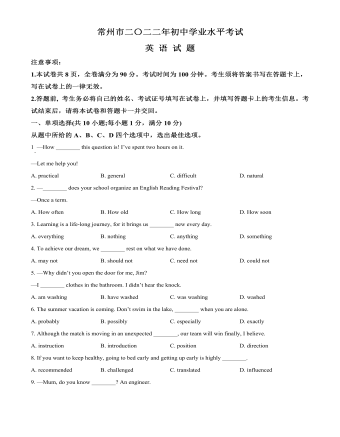
2022年江苏省常州市中考英语真题(原卷版)
At 9 a.m. , he drives to primary schools and middle schools in Xi’an, ShaanxiProvince, to teach students about Shaanxi kuaiban. It is a traditional Chineseform of storytelling to the rhythm(节奏) of bamboo clappers(响板), whichthe art form is named after. Sometimes, he helps students prepare forcompetitions. Usually, his classes run until about 6. p.m. , and then hereturns home to prepare classes for the next day.
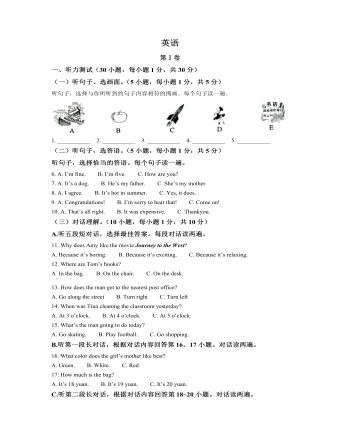
2022年广西贺州市中考英语真题(原卷版)
Once upona time, two brothers lived in a village. They were both famers and grew corn.The elder brother had many children to feed. The younger brother also had a bigfamily to look after. Although the brothers were poor, they lived happily.
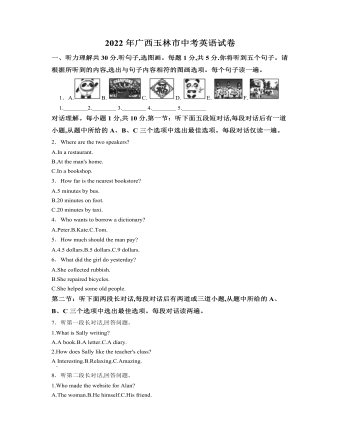
2022年广西玉林市中考英语真题(原卷版)
Lu Junling, a security guard from Hebei University, became popularon the Internet. As an ordinary (平凡) person, though Lu Junling is more than 50 years old, hememorizes English vocabulary for CET 6 under the street lights every day justto improve himself. When he is free, he also writes novels and sings operas.That’s not all! Painting, music, kongfu, ancient poems, etc. are all hishobbies. So a number of people call him “treasure security guard (宝藏保安)”. Lu Junling said, “If I want to become an artist, I will alwayswork hard for my dream!” Mr. Lu’s words live in many people’s memory.
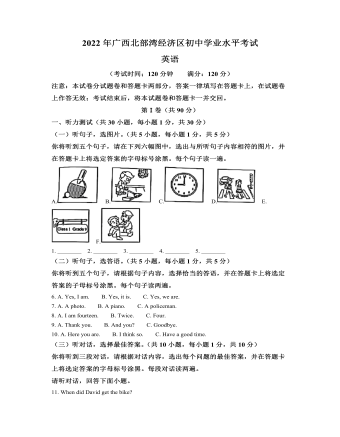
2022年广西北部湾经济区中考英语真题(原卷版)
Ibelieved that I was right and he was wrong, and Tony believed that I was wrongand he was right. Our teacher, a kind and smart lady, decided to teach us alesson. She brought us to the front of the class and placed him on one side ofher desk and me on the other. In the middle of her desk was a large and roundobject. I could clearly see that it was black. The teacher asked us what colorthe object was. “White,” Tony answered. I couldn’t believe he said the object waswhite! “Clearly, it was black!” Another argument started between Tony and me,this time about the color of the object.
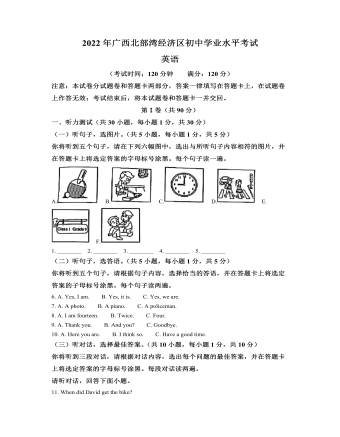
2022年广西北部湾经济区中考英语真题(原卷版)
By usingthis method, the study found that red meats were the most unfriendly foods tothe environment. Keeping farm animals produces a large number of methane(甲烷)that keeps 30 times more heat than CO2. As well asmaking the earth warmer, eating too much red meat is known to increase the riskof a few illnesses, such as heart trouble.
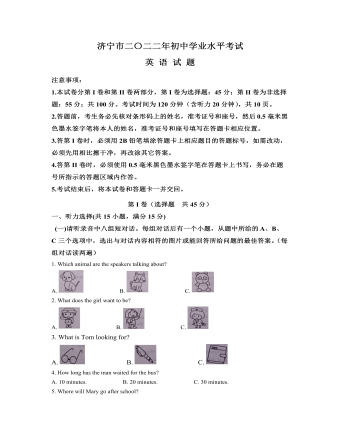
2022年山东省济宁市中考英语真题(原卷版)
Each ofthem has their own experience- two people with synesthesia may both “feel”music, but they almost never feel the music in the same way. For example, onemay feel the music of the violin lightly brushing his face; the other may feelit on her ankle (脚踝). And one’s experience of synesthesia is alwaysthe same. If they see the number 5 in the color blue, then 5 is blue every timethey see it.
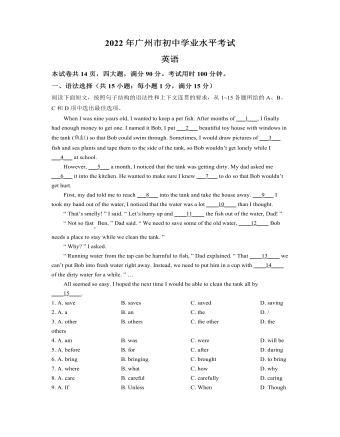
2022年广东省广州市中考英语真题(原卷版)
Slowlybut surely, Amy and her grandparents were making progress. Boxes of all sizeswere placed on top of each other throughout the house. Amy’s grandparents hadlived in the house for years and they had collected many things.
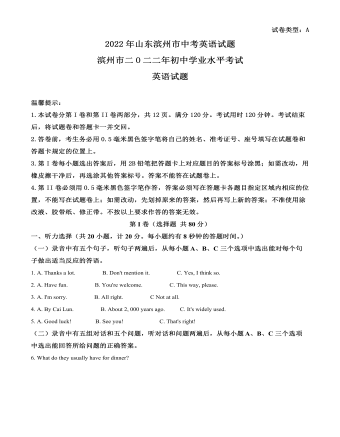
2022年山东省滨州市中考英语真题(原卷版)
As thegovernment encourages the renaissance (复兴) of traditional culture,Hanfu is getting more and more popular with the teenagers. Every year, we canenjoy different Hanfu shows around the cities. And now quite a few Hanfu clubshave been set up in universities. Members usually wear Hanfu at theirgraduation ceremonies or during holidays. Some even wear Hanfu on regular days,too. And these fans created a special day—China Haniu Day to celebratetraditional Chinese clothing. It falls on the third day of the third month inChinese lunar calendar (阴历).
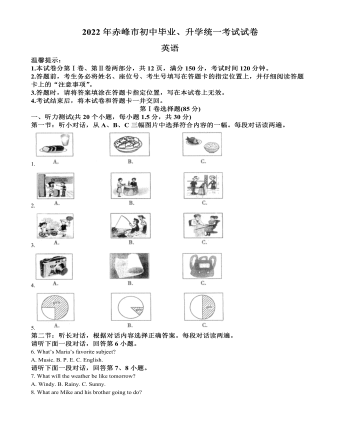
2022年内蒙古赤峰市中考英语真题(原卷版)
We allknow that rice, wheat and corn are staples, but do you know there is anotherkind of staple food—potatoes? Potatoes have many advantages. Theyare a good source of vitamin C and potassium(钾). A potato’s vitamin C isas rich as 10 apples. What’s more,potatoes are low in calories(卡路里)-onlythree fourths of the same amount of wheat and corn, according to People’s Daily. Potatoes are easy togrow. It can be grown in both the north and the south during winter, spring andautumn. The plant is also able to bear drought(干旱). Some areas of China arefacing water shortages, so the potato is safe to grow.
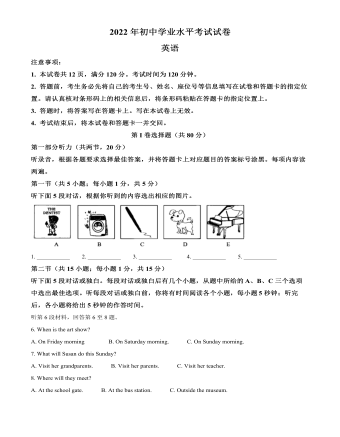
2022年内蒙古包头市中考英语真题(原卷版)
Locatedin the mountains about 100 miles from Los Angeles, the Idyllwild Arts Academyis a boarding school for young artists. It offers training in arts, likedrawing, painting, photography and cinema, along with programmes for theperforming arts. The school’s quiet, rural location also makes it a verypeaceful and beautiful place to learn. THE NATIONAL CIRCUS(杂技)SCHOOL
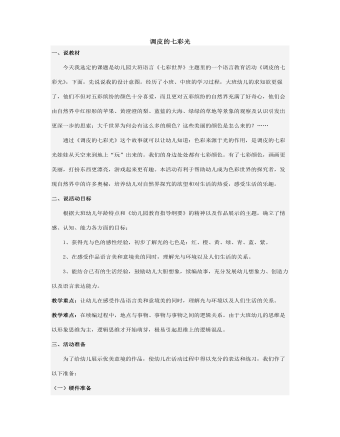
调皮的七彩光说课稿
今天我选定的课题是幼儿园大班语言《七彩世界》主题里的一个语言教育活动《调皮的七彩光》,下面,先说说我的设计意图。经历了小班、中班的学习过程,大班幼儿的求知欲更强了,他们不但对五彩缤纷的颜色十分喜爱,而且更对五彩缤纷的自然界充满了好奇心,他们会由自然界中红彤彤的苹果、黄澄澄的梨、蓝蓝的大海、绿绿的草地等景象的观察及认识引发出更深一步的思索:大千世界为何会有这么多的颜色?这些美丽的颜色是怎么来的?…… 通过《调皮的七彩光》这个故事就可以让幼儿知道:色彩来源于光的作用,是调皮的七彩光娃娃从天空来到地上“玩”出来的。我们的身边处处都有七彩颜色。有了七彩颜色,画画更美丽,打扮东西更漂亮,游戏起来更有趣。本活动有利于帮助幼儿成为色彩世界的探究者,发现自然界中的许多奥秘,培养幼儿对自然界探究的欲望和对生活的热爱,感受生活的乐趣。
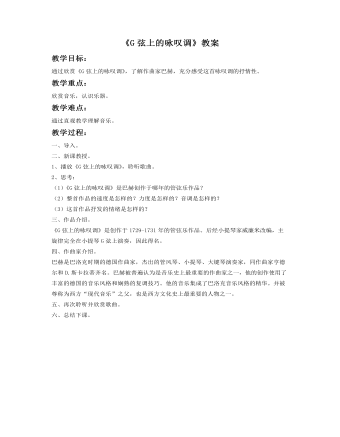
《G弦上的咏叹调》教案
《G弦上的咏叹调》是创作于1729-1731年的管弦乐作品。后经小提琴家威廉米改编,主旋律完全在小提琴G弦上演奏,因此得名。巴赫是巴洛克时期的德国作曲家,杰出的管风琴、小提琴、大键琴演奏家,同作曲家亨德尔和D.斯卡拉蒂齐名。巴赫被普遍认为是音乐史上最重要的作曲家之一,他的创作使用了丰富的德国的音乐风格和娴熟的复调技巧。他的音乐集成了巴洛克音乐风格的精华。并被尊称为西方“现代音乐”之父,也是西方文化史上最重要的人物之一。
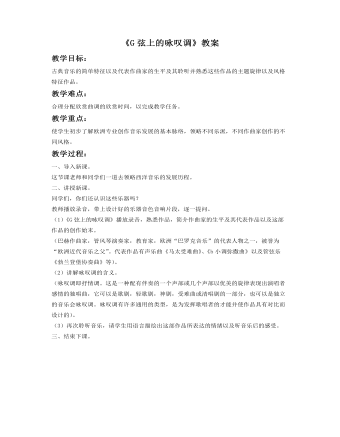
《G弦上的咏叹调》教案
教学过程:一、导入新课。这节课老师和同学们一道去领略西洋音乐的发展历程。二、讲授新课。同学们,你们还认识这些乐器吗?教师播放录音,带上设计好的乐器音色音响片段,逐一提问。(1)《G弦上的咏叹调》播放录音,熟悉作品,简介作曲家的生平及其代表作品以及这部作品的创作始末。(巴赫作曲家,管风琴演奏家,教育家,欧洲“巴罗克音乐”的代表人物之一,被誉为“欧洲近代音乐之父”。代表作品有声乐曲《马太受难曲》、《b小调弥撒曲》以及管弦乐《勃兰登堡协奏曲》等)。
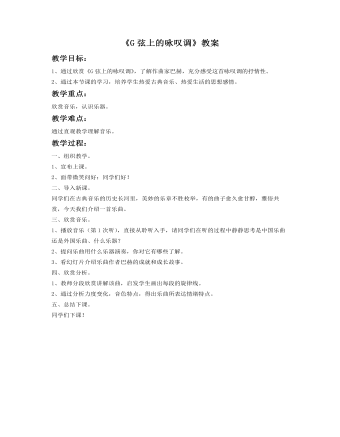
《G弦上的咏叹调》教案
教学过程:一、组织教学。1、宣布上课。2、面带微笑问好:同学们好!二、导入新课。同学们在古典音乐的历史长河里,美妙的乐章不胜枚举,有的曲子愈久愈甘醇,雅俗共赏,今天我们介绍一首乐曲。三、欣赏音乐。1、播放音乐(第1次听),直接从聆听入手,请同学们在听的过程中静静思考是中国乐曲还是外国乐曲、什么乐器?2、提问乐曲用什么乐器演奏,你对它有哪些了解。3、看幻灯片介绍乐曲作者巴赫的成就和成长故事。四、欣赏分析。1、教师分段欣赏讲解该曲,启发学生画出每段的旋律线。2、通过分析力度变化,音色特点,得出乐曲所表达情绪特点。五、总结下课。
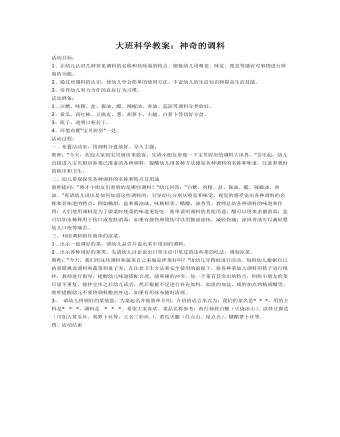
大班科学教案:神奇的调料
2、通过对调料的认识,使幼儿学会简单的使用方法。丰富幼儿的生活知识和提高生活技能。3、培养幼儿努力合作的良好行为习惯。活动准备:1、白糖、味精、盐、酱油、醋、辣椒油、香油、蒜泥等调料分类放好。2、黄瓜、西红柿、豆腐皮、葱、胡萝卜、火腿、白萝卜等切好分盘。3、筷子、透明口杯若干。4、环境布置“宝贝厨房”一处。活动过程:一、布置活动室,将调料分盘放好。导入主题:教师:“今天,欢迎大家到宝贝厨房来做客,先请小朋友参观一下宝贝厨房的调料大世界。”音乐起,幼儿直接进入宝贝厨房参观已准备的各种调料,提醒幼儿用各种方法感知各种调料的名称和味道,注意参观时的秩序和卫生。

综合教案有用的报纸
一次,我有意将废旧报纸投放于晨间桌面、体育区、语言区、表演区等各区域活动,惊奇的发现,晨间桌面他们会用它来折飞机呀、撕碎片呀、团纸球呀,语言区、表演区他们会像真有回事儿似的学爸爸、奶奶看报呀……在成人眼中不起眼的废旧报纸真的成了孩子们的宝贝。经过多次仔细观察,我发现孩子们虽然兴趣浓厚,可对报纸的玩法、利用性还是存在着局限性。新《纲要》中指出:幼儿是教育活动的积极参与者而非被动接受者,活动内容必须与幼儿兴趣、需要及接受能力相吻合。我想,作为教师,应根据幼儿的兴趣、需要和原有经验,引导幼儿走向最近发展区。由此产生了中班综合活动——《有用的报纸》。开展这一活动,孩子们要有一定的基础。我班幼儿已有折、剪、团等用废旧报纸制作的经验。这一活动适合于中班下学期的小朋友。活动设计:一、活动目标1、帮助幼儿理解故事内容,增强爱惜报纸、保护环境的意识2、了解废旧报纸的再可利用性,能想方设法利用废旧报纸,对报纸制作产生兴趣二、重点、难点1、故事内容以及对故事中报纸不同情绪的感知2、想方设法再利用废旧报纸及用旧报纸制作三、活动准备1、事先排练四位大班幼儿担任小小模特儿的角色(身穿报纸服装、头戴报纸头饰,手拿报纸道具,如:纸伞、纸球、纸棒、纸辫子等随乐表演)2、废旧报纸许多,剪刀、胶水、水彩笔、旧图书、白纸、蜡笔、蛋、脏皮鞋等3、轻音乐、故事录音(见后)4、多媒体课件5、事先排练好二段情境表演四、活动过程1、幼儿观看模特儿表演,初步感知旧报纸的用途师:哎呀!小朋友们快看,来了一群小小模特儿,她们身上的衣服多有趣呀!(幼儿观看表演,模特定格)提问:(1)她们身上的衣服是什么做成的呀?(报纸) (2)报纸做的衣服漂亮吗?(漂亮)报纸还做成了些什么呀?(纸球、纸棒、纸辫子、纸伞、纸扇子等)
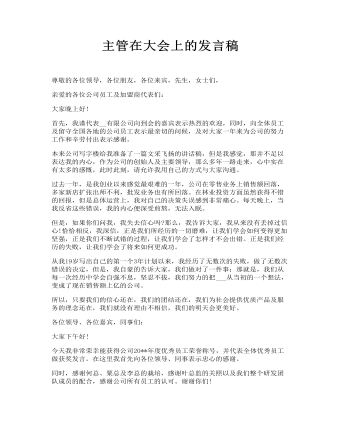
主管在大会上的发言稿
公司成立伊始,我便有幸加入到这个团队,几年来,我并没有为公司做出惊天动地的大贡献,更没取得特别值得炫耀可喜的成绩,我只是努力做好自己的本职工作,尽自己的能力尽快的去完成每一次任务,总结自己的经验,从经验中学习,在失败中成长。当选为优秀员工让我们觉得很自豪与光荣,它印证了我们工作的进步和成绩。同时它也是一种动力,促使我们更加勤奋与努力,去更好地完成每一件事情,为公司创造更大的效益。

在天晴了的时候(说课稿)
二、说教学目标 根据义务教育语文课程标准和本课的特点,我将本课的教学目标确定为以下几点: 1、能够正确、流利、有感情地朗读课文,背诵课文。 2、引导学生通过自学,运用已掌握的识字方法自主识字,会认7个生字,查阅字典、联系上下文理解词语。自主积累词语。 3、体会这首诗所包含的思想感情。通过学习课文,激发学生热爱生活、热爱大自然的思想感情。 根据三个教学目标和课文特点,我确定了以下教学重点: 教学重点:通过有感情的朗读,逐层次理解重点字词,关键句子,体会诗歌所包含的思想感情。
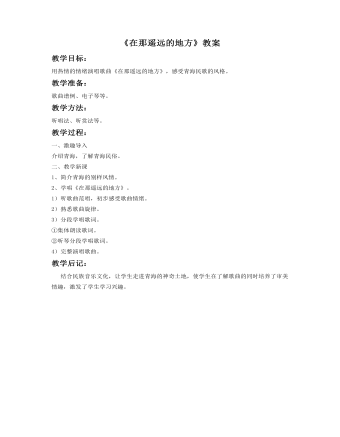
《在那遥远的地方》教案
教学目标:用热情的情绪演唱歌曲《在那遥远的地方》,感受青海民歌的风格。教学准备:歌曲谱例、电子琴等。教学方法:听唱法、听赏法等。教学过程:一、激趣导入介绍青海,了解青海民俗。二、教学新课1、简介青海的别样风情。2、学唱《在那遥远的地方》。 1)听歌曲范唱,初步感受歌曲情绪。2)熟悉歌曲旋律。3)分段学唱歌词。①集体朗读歌词。②听琴分段学唱歌词。4)完整演唱歌曲。教学后记:结合民族音乐文化,让学生走进青海的神奇土地,使学生在了解歌曲的同时培养了审美情趣,激发了学生学习兴趣。
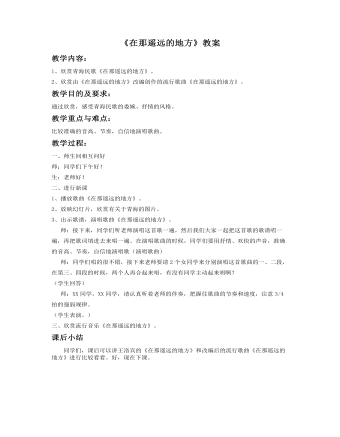
《在那遥远的地方》教案
教学过程:一、师生间相互问好师:同学们下午好!生:老师好!二、进行新课 1、播放歌曲《在那遥远的地方》。2、放映幻灯片,欣赏有关于青海的图片。3、出示歌谱,演唱歌曲《在那遥远的地方》。 师:接下来,同学们听老师演唱这首歌一遍,然后我们大家一起把这首歌的歌谱唱一遍,再把歌词填进去来唱一遍。在演唱歌曲的时候,同学们要用抒情、欢快的声音,准确的音高、节奏,自信地演唱歌(演唱歌曲) 师:同学们唱的很不错,接下来老师要请2个女同学来分别演唱这首歌曲的一、二段,在第三、四段的时候,两个人再合起来唱,有没有同学主动起来唱啊?(学生回答) 师:XX同学,XX同学,请认真听着老师的伴奏,把握住歌曲的节奏和速度,注意3/4拍的强弱规律。(学生表演。)三、欣赏流行音乐《在那遥远的地方》。